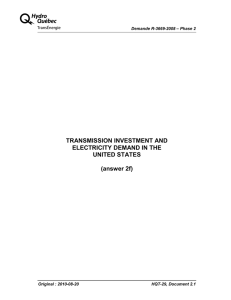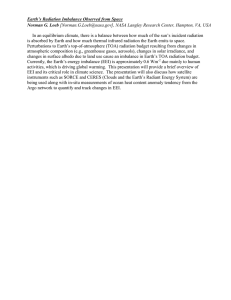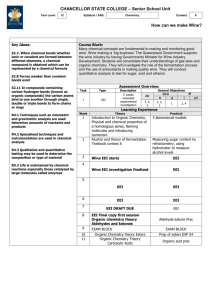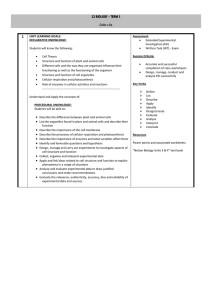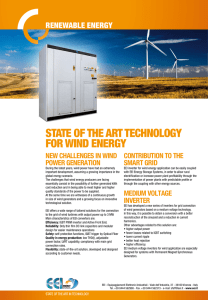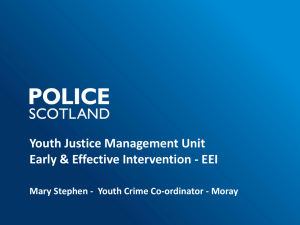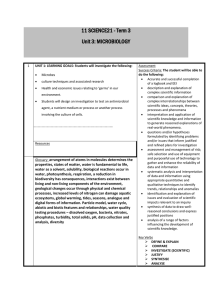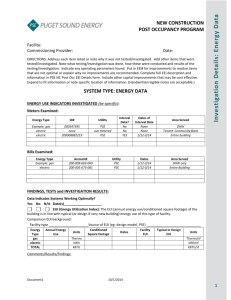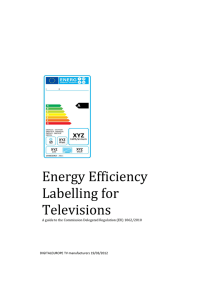EXECUTIVE SUMMARY
advertisement
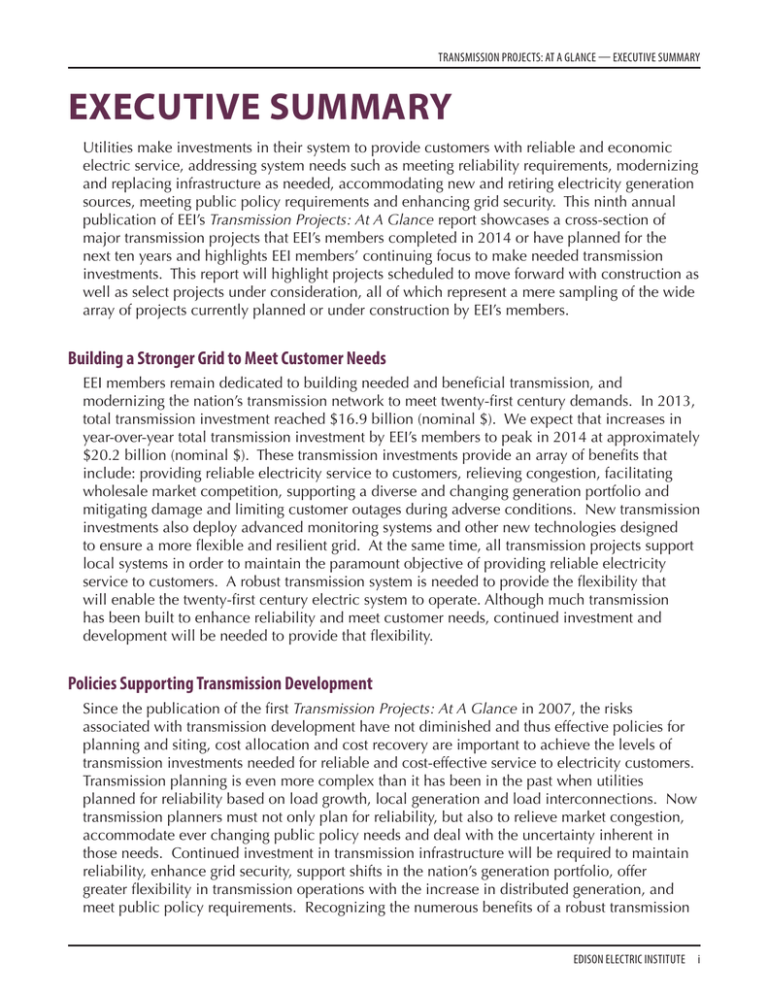
TRANSMISSION PROJECTS: AT A GLANCE — Executive Summary EXECUTIVE SUMMARY Utilities make investments in their system to provide customers with reliable and economic electric service, addressing system needs such as meeting reliability requirements, modernizing and replacing infrastructure as needed, accommodating new and retiring electricity generation sources, meeting public policy requirements and enhancing grid security. This ninth annual publication of EEI’s Transmission Projects: At A Glance report showcases a cross-section of major transmission projects that EEI’s members completed in 2014 or have planned for the next ten years and highlights EEI members’ continuing focus to make needed transmission investments. This report will highlight projects scheduled to move forward with construction as well as select projects under consideration, all of which represent a mere sampling of the wide array of projects currently planned or under construction by EEI’s members. Building a Stronger Grid to Meet Customer Needs EEI members remain dedicated to building needed and beneficial transmission, and modernizing the nation’s transmission network to meet twenty-first century demands. In 2013, total transmission investment reached $16.9 billion (nominal $). We expect that increases in year-over-year total transmission investment by EEI’s members to peak in 2014 at approximately $20.2 billion (nominal $). These transmission investments provide an array of benefits that include: providing reliable electricity service to customers, relieving congestion, facilitating wholesale market competition, supporting a diverse and changing generation portfolio and mitigating damage and limiting customer outages during adverse conditions. New transmission investments also deploy advanced monitoring systems and other new technologies designed to ensure a more flexible and resilient grid. At the same time, all transmission projects support local systems in order to maintain the paramount objective of providing reliable electricity service to customers. A robust transmission system is needed to provide the flexibility that will enable the twenty-first century electric system to operate. Although much transmission has been built to enhance reliability and meet customer needs, continued investment and development will be needed to provide that flexibility. Policies Supporting Transmission Development Since the publication of the first Transmission Projects: At A Glance in 2007, the risks associated with transmission development have not diminished and thus effective policies for planning and siting, cost allocation and cost recovery are important to achieve the levels of transmission investments needed for reliable and cost-effective service to electricity customers. Transmission planning is even more complex than it has been in the past when utilities planned for reliability based on load growth, local generation and load interconnections. Now transmission planners must not only plan for reliability, but also to relieve market congestion, accommodate ever changing public policy needs and deal with the uncertainty inherent in those needs. Continued investment in transmission infrastructure will be required to maintain reliability, enhance grid security, support shifts in the nation’s generation portfolio, offer greater flexibility in transmission operations with the increase in distributed generation, and meet public policy requirements. Recognizing the numerous benefits of a robust transmission EDISON ELECTRIC INSTITUTE i TRANSMISSION PROJECTS: AT A GLANCE — Executive Summary system and the inherent risks and challenges of developing transmission are unlike any other utility plant, EEI’s members have a long history of working with policymakers and regulators to support effective policies, such as appropriate returns on equity, to address the substantial risks of developing, constructing, operating and maintaining transmission infrastructure, as well as the challenges of raising needed capital to fund transmission development. The Energy Policy Act of 2005 (“EPAct 2005”) set forth several statutory requirements intended to support transmission investment, and in 2012 the Federal Energy Regulatory Commission (“FERC”) reaffirmed its pricing policy providing incentive rate treatments to assist in mitigating the risks associated with developing, constructing, operating, and maintaining transmission infrastructure. In addition, FERC advanced its strategic goal of supporting the development of transmission by enabling regional and interregional coordination processes and supporting allocation of costs for the selected transmission solutions that meet customer and system needs. In June 2014, FERC issued its Opinion No. 531 adopting a new two-stage methodology for calculating return on equity as well as providing guidance on the treatment of rates of return for transmission investment. With this new policy, FERC should continue to foster the construction and modernization of beneficial transmission by balancing the need to promote investment in long-term infrastructure assets with the short-term, cyclical movements in the capital markets and ensuring sufficient access to capital to developers. Industry Transmission Development Over 170 projects are highlighted in this report, totaling approximately $47.9 billion in transmission investments through 2025.1 These figures represent only those projects EEI members wish to highlight. Due to large project completions, changing projections of system needs and member decisions regarding which projects to report, these figures may not be wholly-comparable to figures in prior reports and are not indicative of overall transmission investment trends.2 Consistent with federal and state policies, transmission projects are planned through the use of open and transparent processes that include analysis and consideration on a comparable basis of proposed transmission solutions and other alternate solutions. This ongoing evaluation and reevaluation of projects ensure that efficient and costeffective transmission solutions are ultimately constructed. This report captures those projects that companies wish to highlight with the understanding that some projects may not proceed forward with construction. As such, approximately $10.5 billion of the reported $47.9 billion are projects in the conceptual or initial planning phase or subject to approval in regional planning processes. Since transmission projects address an array of needs and deliver a number of benefits, most projects in this report are multifaceted. That is, they are not developed solely to meet any one specific purpose. Accordingly, one project may fall into more than one transmission investment category. Of the total $47.9 billion worth of transmission projects highlighted in this report, interstate transmission projects represent $19.2 billion (40 percent); projects 1 This investment is only a portion of the total transmission investment anticipated through 2025 by EEI’s members. 2 For complete investment figures, please see the “Historical and Projected Transmission Investment” chart on page v of this report. ii EDISON ELECTRIC INSTITUTE TRANSMISSION PROJECTS: AT A GLANCE — Executive Summary supporting the integration of renewable resources represent approximately $22.1 billion (46 percent); projects where EEI member companies are collaborating with other utilities, including non-EEI members, to develop the project represent approximately $17.4 billion (36 percent); and high voltage projects of 345 kV and above represent approximately $31.5 billion (66 percent) (nominal $).3 3 Cumulative percentages do not add up to 100 percent as many projects are included in more than one category. Percentages represent the portion of total investment that each category comprises. EDISON ELECTRIC INSTITUTE iii TRANSMISSION PROJECTS: AT A GLANCE — Executive Summary iv EDISON ELECTRIC INSTITUTE
